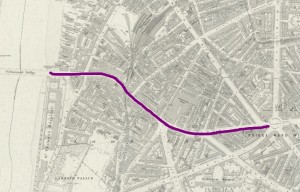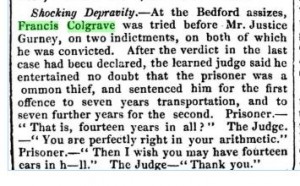
It was at St Mary Newington in Surrey on Monday 7 December in 4th year of Queen Victoria (1840) when Isabella Watkins was convicted of a felony using the name Mary Johnson. This record was found while I was visiting the National Archives at Kew in 1990. The reference was HO 27/65. But using England and Wales Criminal register 1791-1892, I could find no reference to her name being Isabella Watkins. Instead it was Mary Johnson (16) who was given three months imprisonment for larceny on this date.[1]
A little over three months later, Isabella Watkins of the parish of St Mary Lambeth was charged on 15 March 1841 of stealing two shawls valued one pound from Isaac Atkinson and Thomas Coates who owned a shop on Westminster Bridge Road.[2] This road in Surrey has Newington on one side and Lambeth on the other.
Two weeks later, she was tried at the Surrey Assizes and sentenced to seven years transportation. According to her conduct record, she had been convicted before, serving three months for stealing a dress, 21 days for stealing stockings and two months for stealing dress material called Mousseline de Laine. Isabella stated ‘I lived the last two years by thieving.’ [3] No more references to Isabella can be found in the criminal register for stealing stockings and dress material.

The newspaper report of her trial mentions she was a respectable looking young woman; maybe this was why she stole clothing, especially fancy dress material. But she was also a vocal individual. Baron Parke, the judge at her trial, was known to be a very straight speaking man and I noticed in other trials he presided over that repeat offenders were usually transported. He was looking after the tradespeople who had to be protected from others like Isabella.[4]

Apparently Isabella and her soon to be husband Francis Colgrave were like minded in the way they treated the judge when he pronounced sentence upon them at court.[5]
The convict transport Garland Grove had docked at the London Customs House at Woolwich in early April.[6] Where had Isabella been held between her trial date and 12 April? The gaol report on her conduct record mentions she was bad but having searched records for many gaols in the area of London and Surrey, nothing has been found telling us where she was incarcerated. Isabella is also missing on the census taken on 6 June 1841; I now realise she would have been travelling down the Thames on the evening it was taken.
It was on 5 June 1841 when Isabella departed London, heading first to Gravesend then to the town of Deal near the area of the North Sea known as The Downs.[7] This is where many ships would anchor until fair weather allowed them to sail out into the English Channel.
The barque Garland Grove, which was built in 1820, arrived in Hobart Town, Van Diemen’s Land on 10 October 1841. The master for this trip was William Forward and the surgeon superintendent was Robert Dobie. The trip took 109 days.[8] Isabella must have had an uneventful voyage as she was not mentioned in the surgeon superintendent’s medical journal as having been in sick bay at all. But the surgeon’s report on her conduct record mentions she was bad. This must relate to her behaviour on board rather than her health. Despatches and newspapers dated up to 24 June were sent onboard from England; many related to the Corn Laws being discussed in Parliament at that time.[9]
Upon arrival in Van Diemen’s Land, Isabella was probably one of the 80 convicts from the Garland Grove who were sent to Launceston as less than 4 months later she had committed her one and only offence noted on her conduct record below.

It was on 10 February 1842 when she was given one month hard labour at the Launceston House of Correction or Female Factory. This was for disobedience of orders and insolence while working for Mr Legge (most probably Robert Vincent Legge at Cullenswood near Fingal in north eastern Tasmania.) A decision was made by the Lieutenant Governor on 18 February 1842. The magistrate was probably William Franks who was based at Fingal and it was requested that Isabella be returned to Government service after she had finished her time in the factory.[10]
The next piece of paper we find on her trail is that of her permission to marry.[11] Convicts in Van Diemen’s Land had to apply to the Convict Department for permission to marry if they had not finished their sentence.
Like many female convicts at that time, they were encouraged to marry about a year after arriving in VDL and so it was on 14 November 1842 that Isabella married Francis Coldgrave (Colgrave) from Evandale. They were married at the newly built St Thomas Anglican Church at Avoca.[12]

Over the next few years, the only times Isabella was mentioned in the newspapers was when gaining her ticket of leave in 1845, being recommended for her conditional pardon in 1846 and receiving that pardon in 1847.[13]
In her 48 years of marriage to Francis, they raised a family of nine children (two daughters and seven sons). They remained in the district of Evandale where at one stage they ran a boarding house and mention was made in the local paper of a murder on the night of 17 February 1861.[14]
They must have had a very loving and close relationship as Francis died on 24 October 1890 aged 85 and just over a week later Isabella died on 3 November aged 67.[15]
But the questions still are:
Is she Isabella Watkins or Mary Johnson? Is she from Yorkshire or Surrey?
Maybe we will never know the answers but Isabella Watkins, either convict or free woman, raised a fine family, with hundreds of descendants still living in Tasmania today especially around Evandale.
References
[1] England and Wales Criminal register 1791-1892: Class: HO 27; Piece: 62; Page: 243 , 1840 Mary Johnson viewed 17 May 2016
[2] The National Archives, ASSI 94/2329, Isabella Watkins, viewed June 1990
[3] TAHO, CON 40/1/10, p228, Conduct record Isabella Watkins
[4] British Newspapers 1600-1900, The Morning Post (London, England), Sunday, 31 March 1841, p 7 issue 21905, viewed 18 May 2016
[5] British Newspapers 1600-1900, The Lancaster Gazette and General Advertiser, for Lancashire, Westmorland, &c. (Lancaster, England), Saturday, 24 March 1832, p 1 issue 1606, viewed 18 May 2016
[6] British Newspapers 1600-1900, The Morning Post, Tuesday 13 April 1841, Issue 21916, viewed 18 May 2016
[7] British Newspapers 1600-1900, The Morning Chronicle, Saturday 5 June 1841, Issue 22317; The Morning Chronicle, Saturday 19 June 1841, Issue 22329; The Standard, Thursday 24 June 1841, Issue 5309, all viewed 18 May 2016
[8] http://www.hawkesbury.net.au/claimaconvict/shipDetails.php?shipId=764
[9] ‘THE COURIER.’, The Courier (Hobart, Tas. : 1840 – 1859), 15 October 1841, p 2., viewed 18 May 2016, http://nla.gov.au/nla.news-article2955433
[10] TAHO, CON 40/1/10, p228, Conduct record Isabella Watkins
[11] TAHO, CON 52/1/2, p027, Permission to marry Isabella Watkins, Francis Colegrave
[12] TAHO, RGD 37/1/3 No 85, District of Avoca 1842, Marriage certificate Isabella Watkins, Francis Coldgrave
[13] ‘THE GAZETTE.’, Colonial Times (Hobart, Tas. : 1828 – 1857), 28 September 1847, p. 4. , viewed 01 Jun 2016, http:/nla.gov.au/nla.news-article8761424;
[14] ‘SUPREME COURT.’, Launceston Examiner (Tas. : 1842 – 1899), 4 May 1861, p. 3. (MORNING.), viewed 04 Jun 2016, http://nla.gov.au/nla.news-article38759339
[15] TAHO, RGD35/1/59 no 681 District of Evandale 1890, Death certificate Francis Colgrave; TAHO, RGD35/1/59 no 683 District of Evandale 1890, Death certificate Isabel Colgrave
Readers: What was a great website you used that had interesting information relating to your convict ancestor?
PS I still need to insert the images correctly with captions but this is how they copy and pasted across direct from Our Family Past.